Panasonic TX-P65VT50 Review
Panasonic TX-P65VT50
Probably the best TV for watching films on we’ve ever seen.
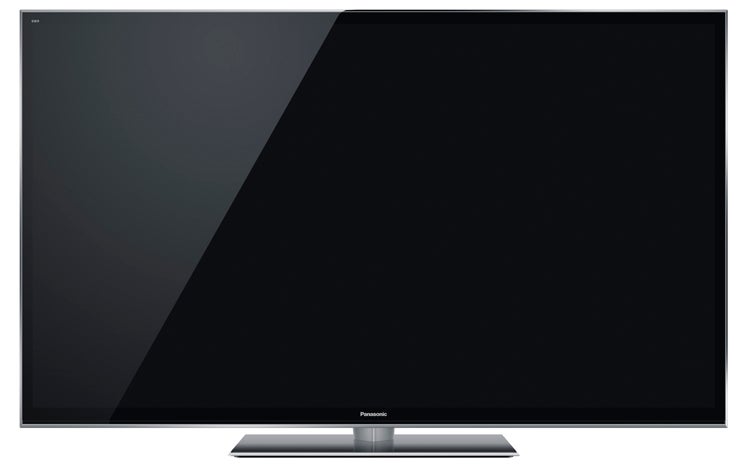
Verdict
Pros
- Stunning cinematic pictures
- Good online service
- Nice looker
Cons
- Jumping brightness when using Dynamic preset with 3D
- Minor dotting noise over skin tones
- Touchpad remote is a pain
Key Specifications
- Review Price: £3499.00
- 65in plasma TV
- 2500Hz subfield drive
- Smart TV functionality
- active 3D playback
- Infinite Black Ultra technology
Right out of the box you get the feeling the Panasonic TX-P65VT50 big-boy flagship isn’t going to let you down. It’s a truly imposing bit of kit, with its surprisingly slender black bezel offset delightfully by a metallic silver outer trim. Also, as usual with Panasonic plasmas, the P65VT50 is built like the proverbial brick outhouse – which is intended to be a compliment.
The P65VT50 is extremely well connected, meanwhile, with highlights of four v1.4 HDMIs, three USB ports, a LAN jack, LNB and RF inputs to support the set’s integrated Freesat HD and Freeview HD tuners, and built-in Wi-Fi.
As you would expect of a 2012 high-end TV, the LAN/WI-Fi and USB jacks provide extensive multimedia support, including streaming from DLNA PCs, access to Panasonic’s increasingly impressive Viera Connect online platform, and playback of a wide variety of multimedia files from USB sticks. Oh, and you can also record from the digital tuners to USB HDDs.
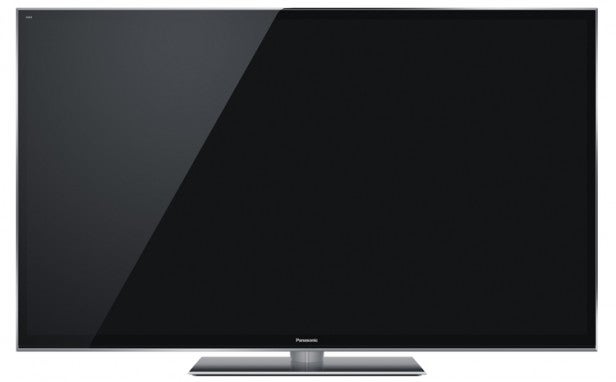
For all its exterior finery, though, it’s inside the Panasonic TX-P65VT50 that you find its flagship heart. For starters, tucked away inside its screen is Panasonic’s latest top-end filter, designed to boost black level depth by stopping ambient light from entering the screen while only slightly compromising the amount of light emerging from behind the screen.
Home cinema special
With this filter in mind, it’s our opinion that while you certainly could use a P65VT50 in a living room so long as you don’t mind dimming the lights to get the best out of it, it’s going to be at its unfettered best when used in a dedicated home theatre room.
Another key flagship element of the P65VT50 is its dual-core processing. This ultra-powerful engine filters into multiple elements of the set’s performance, from allowing you to have up to six different apps and features open simultaneously to improving picture processing.
The app multi-tasking impact of the dual-core processing is very welcome indeed once you’ve gotten used to how it works, making the TV’s multimedia talents feel much more naturally integrated into the TV’s ‘core’. We also found ourselves using a wider range of the TV’s multimedia tools than we did while using Panasonic’s non-dual core 2012 TVs.
We’ll get to the impact of the dual-core processing on picture quality presently, so all we’ll say for now is that it helps the set produce an unprecedented ‘2500Hz’ sub-field drive system (which on paper at least has the potential to take judder removal and motion clarity to a new level), and that it helps the set produce a massive 24,576 steps of colour.
Viera Connect
We’ve pretty much done Panasonic’s Viera Connect online platform to death in the course of our previous 2012 Panasonic TV reviews, so we won’t go into much depth on it again here. Highlights of the service include the BBC iPlayer, YouTube, AceTrax movies, BBC News, Eurosport, Netflix, Fetch TV, Twitter, Facebook, and iConcerts. Plus there’s an internet browser, and an impressively well-developed and presented online Marketplace for buying extra apps and even a few hardware accessories.
The Panasonic TX-P65VT50 is endorsed by the THX group, pointing both to a hopefully impressive picture performance and some onboard THX picture presets – one designed for a dark cinema installation, and one aimed at brighter room use. The P65VT50 is also endorsed by the Imaging Science Foundation (ISF), thanks to its provision of decent colour and gamma management toolsets.
One last feature to mention before finding out how the Panasonic TX-P65VT50 performs is the second ‘touchpad’ remote control that ships with the TV as standard. Unfortunately, while this is a welcome idea, its execution lets it down. The small, round shape of its touchpad and that you have to tap the pad to ‘select’ something both make it a faff to use.
Mesmerising first performance impressions
Following our own advice earlier by running the P65VT50 initially in a darkened room, it’s fair to say we were nothing short of mesmerised by the picture quality it has to offer. Beginning, inevitably, with its truly sensational black level response.
We’re now well used, of course, to seeing inky black colours from Panasonic plasma TVs. But the P65VT50 reaches new black level heights – so much so that it finally challenges the almost mythical prowess of Pioneer’s final KURO generation in this most crucial of picture quality areas.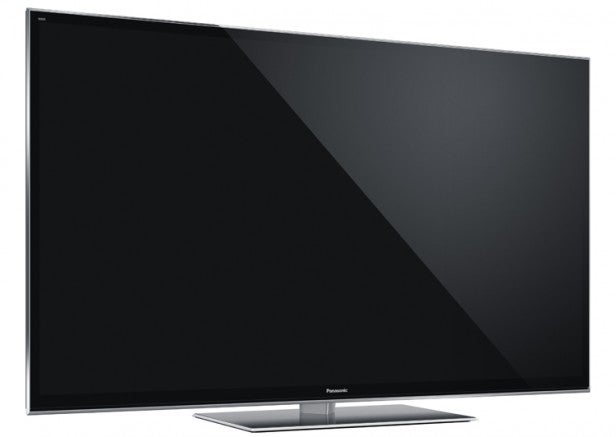
It’s not just the fact that black colours appear with none of the grey misting in evidence with almost all other flat TVs that makes them so wondrous, either. It’s also a huge relief to find no part of even the darkest scenes suffering with the backlight inconsistencies so common with LED TVs. The inky blacks possible on the P65VT50 look equally perfect no matter where they appear on the screen.
The world-beating black levels are given added emphasis, moreover, by the fact that Panasonic’s 2012 panel designs are able to produce so much more brightness than last year’s models without increasing power consumption. This enables the deep blacks to sit right alongside impressively rich colours and much crisper, brighter whites than we’ve become accustomed to seeing from Panasonic plasmas. In short, while the P65VT50’s pictures might not ultimately be as bright as those of the typical LCD TV, their sense of dynamism in a dark room setting is outstanding.
Dual-core bonus
It’s not just the richness of the P65VT50’s colours that makes us happy either. As hoped, the set’s dual-core processing appears to help the screen deliver a vast gamut of colour shades that also, crucially, translates into much smoother, less stripey colour blends than we’ve tended to see before.
With so much flexibility to its palette, it’s no surprise to find the P65VT50 able to deliver impressively natural colours at pretty much all times.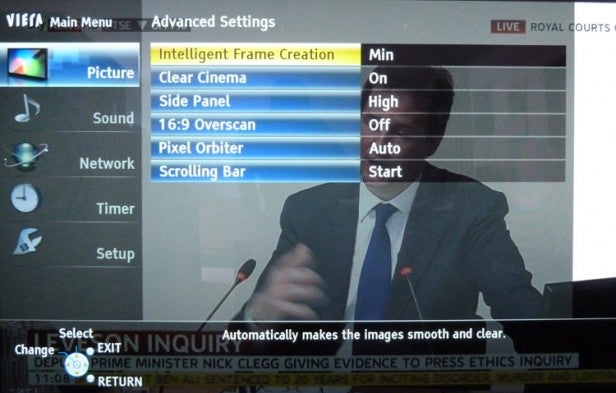
Want some more good news? Then how about the phenomenal amount of detail HD pictures contain. Regardless of whether you’re watching a decent HD broadcast or a pristine Blu-ray movie, the textures, sharpness and clarity evident in the P65VT50’s pictures are just gorgeous. While you can appreciate the benefits of HD even on a TV as small as 19in, it’s when the format is writ as large as 65in that it really comes alive – provided a TV is good enough to make the most out of it, of course.
Light is might
Contributing to the clarity is plasma’s self-emissive nature. That every single pixel in the screen can generate its own level of luminosity means the P65VT50 produces amounts of shadow detail in dark areas and during dark scenes that you simply cannot get on any LCD TV.
The Panasonic TX-P65VT50’s clarity also benefits from the set’s exceptional motion handling. We’re accustomed, of course, to plasma TVs suffering far less with resolution loss over moving objects than the vast majority of LCD TVs. But with its latest flagship Panasonic has also managed to massively reduce the juddering issues that have long been one of the few significant issues we’ve had with the brand’s plasma TVs.
For the best results with motion in the Panasonic TX-P65VT50 we’d (perhaps surprisingly) recommend that you activate the set’s Intelligent Frame Creation processing on its lowest or even mid level. It’s a recommendation we make only because the dual-core processing in the TV enables this processing to deliver its benefits without creating the sort of negative side effects we’d usually expect.
More evidence of the P65VT50’s processing prowess can be seen in the way it upscales standard definition sources to the 65in screen. Standard definition digital broadcasts don’t tend to fare well when pushed to extreme screen sizes, but the P65VT50 manages to add extra detail at the same time as keeping a lid on noise exceptionally well, making even relatively low-quality channels surprisingly watchable.
The P65VT50’s talents continue for the most part with 3D. The full HD nature of its active 3D approach allows its 3D pictures to look detailed and dense despite the screen’s epic size, delivering perhaps the most important reminder of this TV generation of exactly why the active 3D format was invented.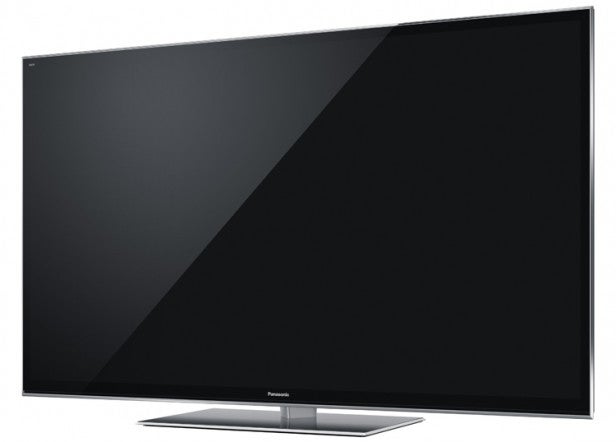
The sheer size of the Panasonic TX-P65VT50’s screen, meanwhile, helps reduce the impact of the shortage of brightness versus 3D LCD TVs that characterises the 3D plasma experience.
Having spotted a little more crosstalk than expected when reviewing the Panasonic P65ST50 recently, it was good to find less of it with this TV. Even the notoriously tough-to-show lantern sequence in Tangled betrayed only the smallest amount of the ghosting flaw.
Keeping crosstalk at bay
Please note, though, that oddly we found we had to restrict the set’s Intelligent Frame Creation system to its Min setting in order to minimise crosstalk. This is a touch unfortunate, as the Min setting isn’t quite strong enough to stop the appearance of some judder during camera pans. But nonetheless, overall the P65VT50’s 3D pictures are hugely impressive and truly immersive – especially given our belief that bigger is always better where 3D is concerned.
The Panasonic TX-P65VT50’s audio is solid but not quite as large in scale as its pictures, and the last test we did on the P65VT50 was to measure its input lag. And there were no nasty surprises here, as we came up with only 40ms at worst when using the TV’s Game preset.
The P65VT50 isn’t perfect, even when used in a dedicated cinema room. As well as the small issues already covered, we noted some very minor dotting noise occasionally momentarily visible over horizontally moving skin tones, and some weirdly severe brightness ‘jumping’ during mid-dark 3D footage if you use the set’s Dynamic preset. Thankfully this distracting issue all but disappears if you use the Normal setting.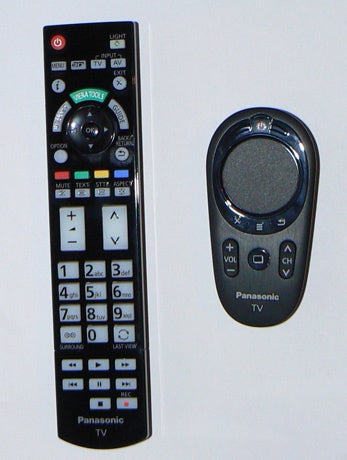
Overall, though, the only TV that can currently hold a candle to the Panasonic TX-P65VT50 as a cinema TV is Panasonic’s own P65ST50. But actually the king-sized screen of the P65VT50 highlights the VT50’s premium advantages over the ST50 models slightly more strongly than the previously reviewed P55VT50 did. So while the P65ST50 remains a terrifically good value alternative to the P65VT50, in this instance we’d recommend trying to find the extra money for the flagship model if you can.
As a living room TV the P65VT50 is potentially a slightly more considered proposition – especially if your room is very bright – on account of its pictures looking less bright with the lights up than those of your typical LCD TV. But Panasonic’s latest panel redesign has at least enabled the P65VT50 to get brighter than last year’s plasma models, so its slightly muted daylight pictures could very well seem a pretty fair price to pay for the picture heroics that emerge when you’ve dimmed the lights.
Verdict
The Panasonic TX-P65VT50 is every inch a flagship TV. In fact, it’s probably the best TV for watching films on we’ve ever seen – and if you’re a movie buff, you can’t really ask for much more than that.
How we test televisions
We test every TV we review thoroughly over an extended period of time. We use industry standard tests to compare features properly. We’ll always tell you what we find. We never, ever, accept money to review a product.
Trusted Score
Score in detail
-
Features 9
-
3D Quality 9
-
Value 8
-
Design 8
-
2D Quality 10
-
Sound Quality 8
Features
| Size (Inch) | 65in |
| Display Type | Plasma |
| Max. Resolution | 1920 x 1080 |
| Full HD 1080p | Yes |
| Digital Tuner | Yes |
| Freeview HD | Yes |
| Freesat HD | Yes |
| 3D Ready | Yes |
| Contrast Ratio | 6,000,000:1 |
| Refresh Rate (Hertz) | 2500 (subfield drive)Hz |
Connectivity
| HDMI | 4 (v1.4) |
| Component | 1 |
| Composite | 1 |
| Scart | 1 (RGB) |
| Digital Audio Out | 1 (optical) |
| Headphone | 1 |
| Charging/Computer Connection | 3 |
| Ethernet | 1 |
| WiFi | Yes (built-in) |
Physical Specifications
| Height (Millimeter) | 891mm |
| Width (Millimeter) | 1499mm |
| Depth (Millimeter) | 50.5mm |
| Weight (Gram) | 42.5g |

